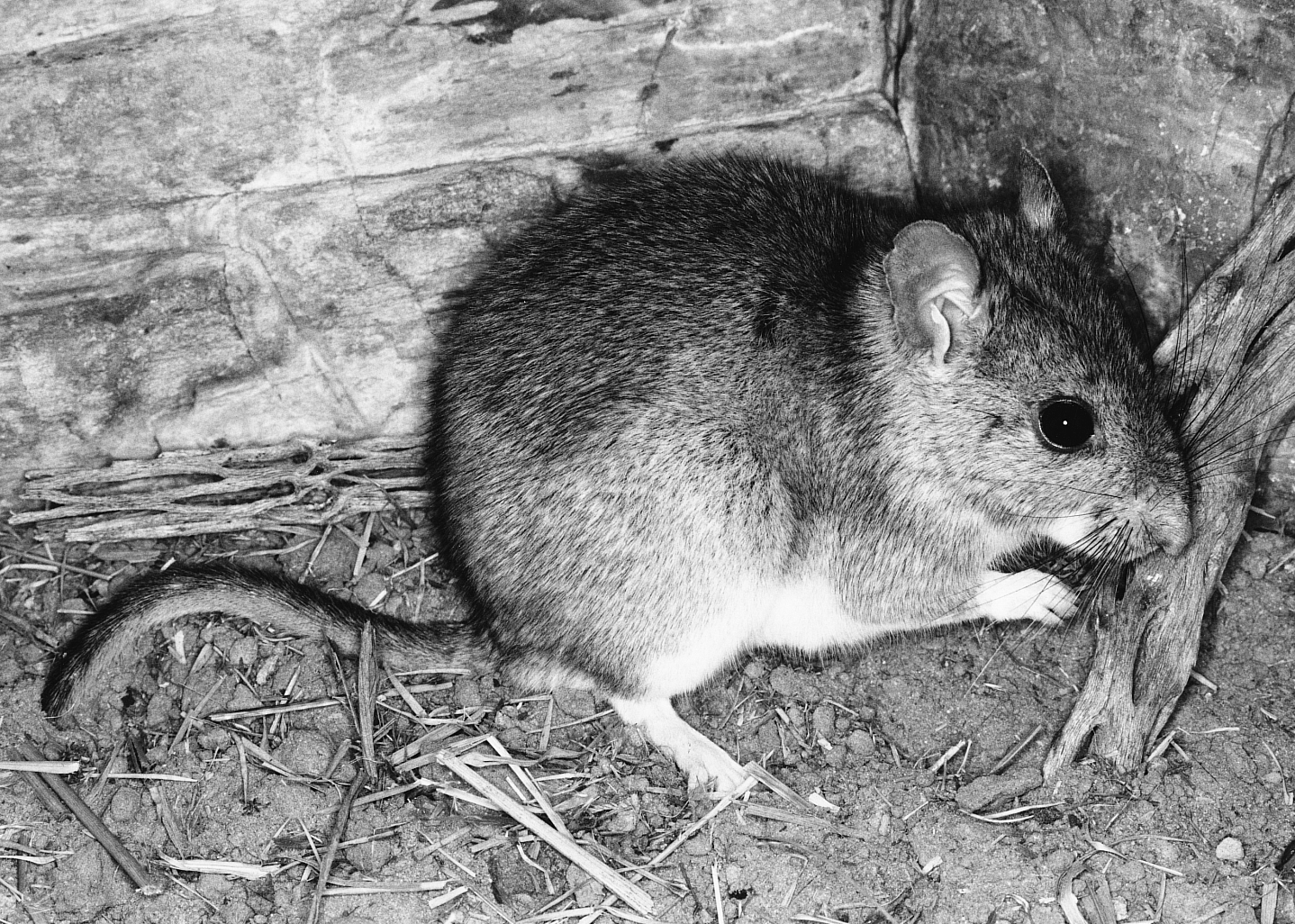SOUTHERN PLAINS WOODRAT
Neotoma micropus Baird 1855
Order Rodentia : Family Cricetidae
DESCRIPTION. A large, gray-colored woodrat with large ears and relatively short, heavy, sparsely haired tail. Differs from N. floridana, to which it is most closely related and which may occur in the same area, in gray, often bluish-gray, dorsal coloration. Upperparts pale drab, mixed with blackish hairs along the back; tail blackish above, grayish below; underparts and feet white. Dental formula: I 1/1, C 0/0, Pm 0/0, M 3/3 × 2 = 16. Averages for external measurements: total length, 351 mm; tail, 163 mm; hind foot, 41 mm. Weight of males, 272–310 g; of females, 204–243 g.

DISTRIBUTION. Found in western two-thirds of state eastward to Johnson County in the north and Calhoun County on the Gulf Coast.

SUBSPECIES. Neotoma m. canescens in the western part of the range in the state and N. m. micropus in the east.
HABITS. This woodrat is characteristic of the brushlands in the semiarid region between the timberlands and the arid deserts to the west. It occurs primarily in valley pastures and around watercourses on the Edwards Plateau. Unlike other woodrats, it is rarely associated with rocks or cliffs; rather, it is usually found associated with cactus or some of the thorny desert shrubs. It is at home in thickets of cacti, mesquite, or thorn bush, where it constructs a midden of sticks, joints of cactus, thorns, and other readily available material. Frequently, an underground burrow system is added, particularly in localities where building materials are not abundant. These middens may be 1 m or more in height with two or more openings near the base to which well-worn trails lead through and over the spiny vegetation. So well protected are these rats by their spiny fortresses that they seldom are disturbed by larger animals. Their food consists almost entirely of vegetation; the thick blades of the prickly pear and the juicy fruits of many species of cactus are favored items. Specific items include the thick basal parts of the leaves of sotol, blades of agaves, beans and pods of mesquite, and acorns. Their food also supplies the necessary water.
In parts of its range, N. micropus is known to breed throughout the year, but on the Llano Estacado pregnant females have been taken from February to May and from July to September. One or two litters may be produced annually. The usual number of young per litter is three but ranges from one to four. The gestation period is about 33 days. At birth, the young weigh about 10 g, but growth is rapid. They are weaned when about 30 days old, and at the age of 3 months are nearly full grown and weigh about 85% as much as adults. At the age of 300 days they are sexually mature.
Under suitable conditions the population density may become high, at which times the southern plain woodrat may compete seriously with livestock and big game animals for forage. Ordinarily, however, they are not serious pests.
POPULATION STATUS. Common. The southern plains woodrat is locally abundant over much of its range in Texas.
CONSERVATION STATUS. The IUCN lists the southern plains woodrat as a species of least concern, and it does not appear on the federal or state lists of concerned species. This species appears to be excluded from, or its numbers greatly reduced in, areas of intensive agricultural activity. Regular plowing, use of defoliants, and the absence of habitat exclude this species from some agricultural areas. There is no reason, however, to place it on any sort of threatened or protected list.
From The Mammals of Texas, Seventh Edition by David J. Schmidly and Robert D. Bradley, copyright © 1994, 2004, 2016. Courtesy of the University of Texas Press.
Natural Science Research Laboratory
-
Address
Museum of Texas Tech University, 3301 4th street, Lubbock, TX 79409 -
Phone
806.742.2486 -
Email
nsrl.museum@ttu.edu

